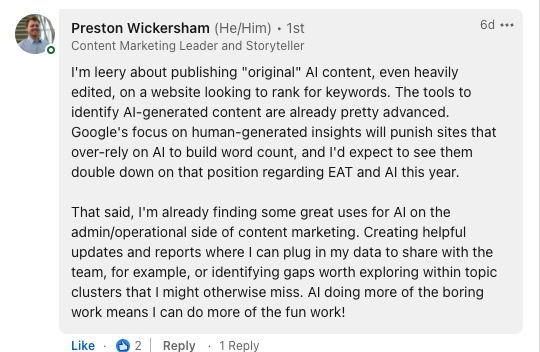
How Are Marketers Using AI-Generated Content? [Poll]
How Are Marketers Using AI-Generated Content? [Poll]
Kelsey Raymond, COO • Intero Digital • February 8, 2023

At the time of writing this, ChatGPT is right at two months old. The AI content writer tool, launched by OpenAI, seems to have taken us into a new phase of AI-generated content and opened up a world of new possibilities for marketers. So much so that Microsoft has invested billions in OpenAI.
ChatGPT is designed to think conversationally, and it works by training the model on a large data set of text, teaching it to predict the next word in a sequence based on the context provided by the words that come before. What’s making it so popular and buzzworthy is that its content often reads like a human being, especially when compared to other AI tools that produce stuttering, rudimentary, or out-of-context copy.
The ChatGPT trend has already “gone meta.” Take this ad for Mint Mobile, voiced by Ryan Reynolds, which ironically uses a ChatGPT script, but then … actually uses a ChatGPT script.
But the reviews are mixed. Google executive John Mueller has stated that AI-generated content goes against Google’s webmaster guidelines and is considered spam. What’s more, Neil Patel found that AI-generated content attracts less traffic and sees lower search results rankings compared to human-created content.
Fascinated by this trend, we put a call out to our social media following to find out more about how AI is showing up in marketing. What is AI-generated content like these days? And is AI-generated content good? We wanted to hear directly from the marketers in our network about how they are using (or not using) AI in their marketing — and why.
How Are Marketers Thinking About AI Content Creation Tools?
We were honestly surprised by the results of our Twitter poll. Only 4% of respondents said they are actively using AI in content creation. This contradicts the flurry of marketers taking to Twitter to talk about all the unique ways they recommend using AI for creative content marketing.
What’s behind this discrepancy? Well, a response to our LinkedIn post might give us a clue into why our network is less inclined to jump into AI-generated content headfirst. Many marketers see AI content creation tools as fast-evolving, and they want to see how the tools will change next before launching into using them for their own content. Marketers are understandably uncertain about how AI-generated content will impact SEO and whether the content that’s created will be perceived as credible. And, because we can reasonably assume that Google is working to stay one step ahead of AI, they figure that it might be a safer bet to hold off until we have more concrete information.

I have the same concerns as Preston regarding AI’s SEO implications. There are already many tools that can detect AI-generated content, and like we mentioned above, Mueller has said outright that Google’s guidelines consider AI-generated content to be spam.
So, we know that Google probably is not going to reward websites that start filling their pages with AI-generated content, but that doesn’t mean there isn’t a place for AI in the content marketer’s tool kit at all.
The Dos and Don’ts of Using AI in the Content Creation Process
How can you create high-quality, expert content efficiently and affordably without completely relying on AI? How can you take advantage of the opportunities for productivity that AI offers while continuing to serve your audience well?
Here are some areas where we recommend using AI in your content marketing strategy, as well as a few areas where it might be best to avoid using AI:
Do use AI-generated content for:
- Research.
AI can help you learn faster. Use it for all kinds of research. Keyword research, for example. Upload an existing list and add to it, or create a new list from scratch based on certain criteria. Research prospects before or during a call to add important context to your pitching and customize your approach. - Refining copy.
In the latter stages of content creation, you just need a machine eye to scan over your prose or your presentation and make sure there are no obvious errors. AI can be a good proofreader for glaring mistakes, but it can also help you summarize a document for quick reading. All of these secondary text tasks that take unnecessary time can be handled by AI tools. - Creating simple scripts.
Not every piece of content will need an editor’s eye. Some scripts are supposed to be simple — for example, a script for initial cold calling or responses to certain frequently asked questions. - Generating ideas.
AI can also be great for simply coming up with ideas. Need to come up with some options for an angle for a piece of content? Use AI to scour through keywords, competitors, and client questions to gather inspiration.
Don’t use AI-generated content for:
- Content for your clients.
If you are lending your voice to someone else’s endeavor, AI tools might not give you the level of care, expertise, and personality you need to do that client justice. Let’s say you’re writing an email or a guest-contributed article on behalf of a client. You need to give that content the consideration and strategic eye that only a human can deliver.
- Blog posts and whitepapers.
These pieces of content are important for your brand because they’re educational and give readers an extended inside look into your ideas and visions. AI might help you research and organize information for these pieces, but the content will also need a human-driven story and voice in order to capture the attention of and engage the audience.
If you’re feeling defeated because you hoped that ChatGPT was the solution to all of your content creation needs, don’t worry. There are still wonderful content creation partners out there who can do the heavy lifting of content strategy, creation, and distribution for you. And there are still plenty of ways to use AI content writer tools to get aspects of your job done more efficiently. Just remember where the helpfulness of AI stops and the need for human insight begins.
